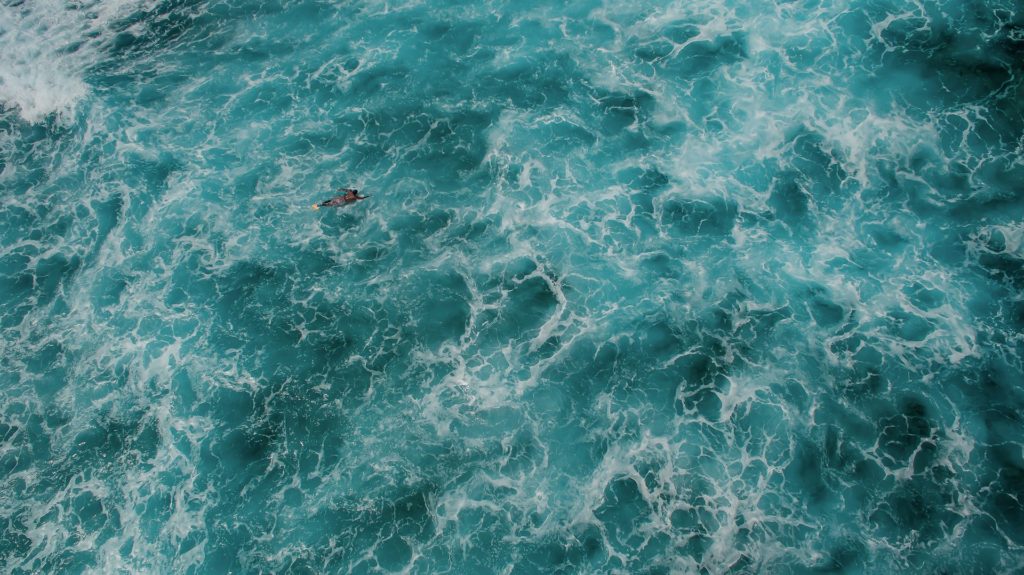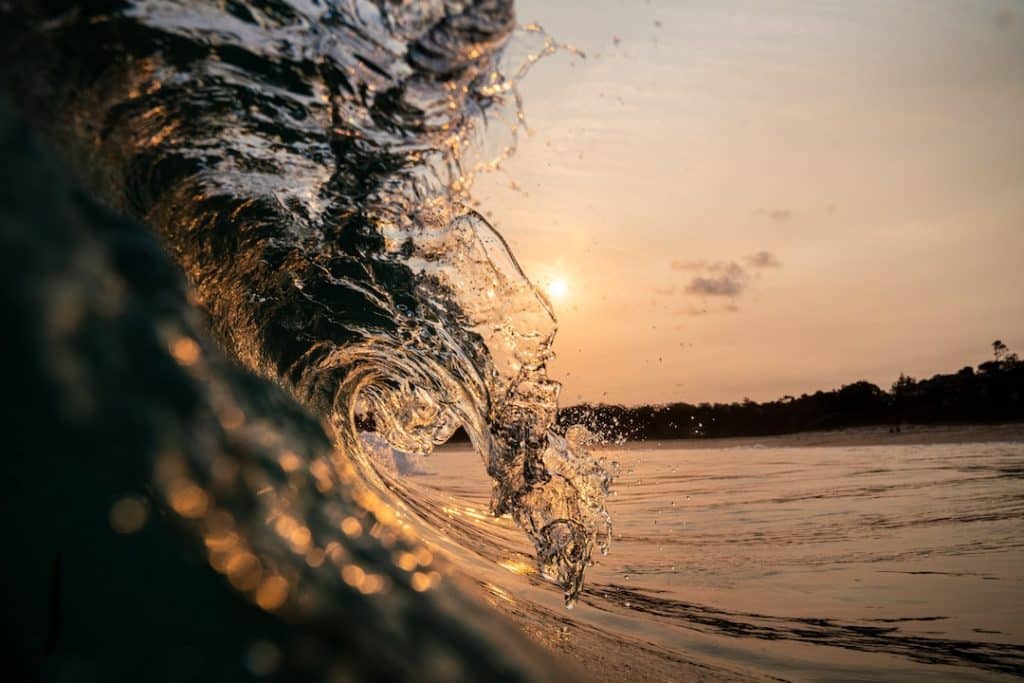Learn how to improve your surfing with these 6 easy steps and a little guidance from Rapture Surfcamps talented team of experienced surf instructors.
Riding the whitewash is fun but sooner or later you’re going to develop a deep and unshakeable desire to surf an unbroken wave. This longing for an open face is what we here at Rapture Surfcamps call surfer’s froth. Which is essentially that feeling every beginner surfer gets when they’re ready to take their skills to the next level.
Surfer’s froth can translate into wanting to paddle out the back for your very first time. Or perhaps it manifests itself as a yearning to experience what it’s like to get barrelled. Either way, the only method for filling up your froth meter is by learning how to improve your surfing. And what better team to learn from than with our experts at Rapture Surfcamps.
Check out how to paddle faster, where the best takeoff zone is and whether or not you should bend at the waist or the knees by reading on below. With these techniques plus some serious dedication, you’ll be shredding in no time at all.
1. Learn how to paddle properly

Paddling might be an afterthought for many people. It doesn’t really come into play when you’re actually riding a wave after all. And as far as learning to surf goes, paddling comes naturally to just about every person who picks up a board.
The thing about paddling though is that when done properly, it makes catching waves and getting out the back infinitely easier. Reaching as far forward as possible with every stroke is one way in which you can generate more power when paddling. Keeping in mind that this involves rotating your shoulders instead of just moving your arms.
Paddling with your fingers almost closed can also help. A small detail no doubt, but one that’s proven to provide lift while in the water and propel you forward more efficiently. Try it the next time you’re catching a fat or mushy wave. We guarantee you’ll notice a difference between this technique and paddling with your fingers closed.
2. Pick your position in the lineup and stick to it

You can paddle around like a person possessed and try to catch every little swell bump that comes your way. Maybe you get lucky, but most of the time you’ll end up chasing your tail. Our advice? Pick your position in the lineup and guard it like you mean it.
Easier said than done of course. But with a little groundwork before you paddle out, finding the best place in the line-up isn’t that hard. Simply identify which part of the break is the take-off zone. Then when you finally paddle out, sit as close as you can to that take-off zone for the best chance of scoring an epic ride. Lining up a landmark on the shore, such as a rock or a tree, will also help you find your place again after catching a wave.
As opposed to always being on the move, sitting in the one spot will help you to conserve energy. Just remember though that as the tide changes, so to will the takeoff spot. So keep your eyes peeled if you see multiple sets begin to break in a different location. Then simply adapt to the new takeoff zone and find another place to sit. This is a great tip for maximizing your wave count the next time you stay in one of our awesome surf camps.
3. Surf what’s in front of you

Sometimes when we paddle out to surf, we paddle out with the goal in mind to try a new maneuver. The problem with this is that you’re no longer surfing to compliment the wave.
If you want to improve your surfing in time for your next overseas surf adventure, a great tip is to always surf what’s in front of you. As opposed to forcing your will on the wave. How do you think good surfers look so good, even when the surf is mediocre? It all comes down to their ability to assess how they’re going to surf a wave on the fly.
A soft shoulder demands a wrapping carve back into the pocket as much as you mum deserves a hug on the second Sunday in May. With re-entries, layback snaps and even aerials also being relegated to certain sections on a wave. The next time you stand up, allow the wave to dictate how you’re going to surf. Instead of the other way around.
4. Keep your back straight

The best surfers in the world surf with an almost perfectly straight back. Watch guys like Kelly Slater, Filipe Toledo and Julian Wilson and you’ll know what we mean. Not only does it make them look super stylish, it also helps them pivot from the waist more efficiently.
Book a surf camp with us and practice standing up on smaller waves. Being mindful to straighten your back and bend at your knees. Once you’ve committed it to muscle memory, you can then start moving onto bigger and better waves and really begin to improve your surfing.
The benefits of surfing with a straight back are twofold. You’ll be able to generate more speed from your turns and at the same time give your style a serious upgrade. Which more than anything will make your surfing look much better than it actually is. At least even if you bog a rail or make a mess out of a turn, you can take comfort knowing your on-wave technique was flawless.
5. Surf even when it’s not perfect

It can be easy to wake up for the early morning surf, only to retreat back to bed when the conditions are less than appealing. What’s harder but decidedly more rewarding is going out when the surf is average. All it takes is one wave to make a session anyway, right? And you’re not going to catch that wave under the duvet cover.
The next time you check the surf and it’s onshore, overcast and a little on the small side, grab a board with more volume and go for a paddle. This is one of the best ways to improve your surfing since you’ll be forced to surf in challenging conditions. As opposed to only surfing when it’s 4 foot, offshore and perfect by any standards.
Anyone can have fun when the waves are really good. It’s when they’re less than stellar that surfing with style becomes more difficult. So the next time you’re faced with the prospect of average conditions, don’t make excuses. Use the opportunity as a way to refine your skills in preparation for your next surf camp.
6. Stay in the pocket of the wave

Every maneuver you perform on a wave requires speed to complete. It carries you through your turns and allows you to stay ahead of the curl or whitewash. But generating this speed and then maintaining it throughout the entirety of the wave isn’t easy. Especially if you’re not used to surfing in the pocket of a wave.
The pocket is the steepest part of the unbroken wave closest to the curl or whitewash. It’s where most of the waves potential energy is located and where you should stay to get maximum speed. Get caught behind the pocket and you’ll end up being rolled by the whitewash. Move too far in front of it and you’ll find yourself on the shoulder, which is generally the flattest part of the wave.
Performing maneuvers in the pocket is a good place to start if you want to improve your surfing. It may take a while to get the hang of first. But by becoming comfortable surfing in the steeper part of the wave, you’ll be able to exploit the wave’s energy as you please. Your chances of doing your first carve or floater without any speed are slim to none anyway. So by staying in the pocket, you’re giving yourself a better opportunity at pulling off your first turn.

Book your stay with us
Improve your surfing at any one of our surf camps today!
We have camps in Nicaragua, Costa Rica, Bali and Portugal. Check all of them and find the best for you.
CHECK NOW

